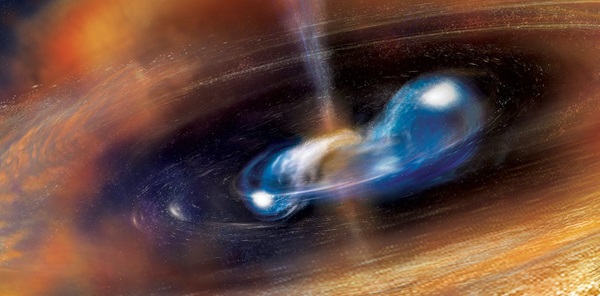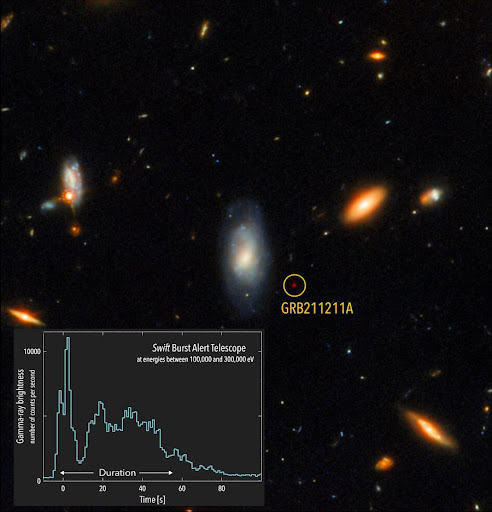Merging neutron stars trigger strange, long-lasting gamma-ray burst
A newly discovered gamma-ray burst is challenging astronomers’ theories about these powerful cosmic explosions that make gold, uranium, and other heavy metals.
The Research Brief is a short take about interesting academic work.

A. Simonnet (Sonoma State University) and NASA’s Goddard Space Flight Center, CC BY-ND
The big idea
In a recent study, we documented a spectacular gamma-ray burst from the constellation Boötes that lasted for about a minute. This discovery calls into question what astronomers believe to be true about some of the universe’s most powerful phenomena.
On December 11, 2021, while the satellite circled the planet, the Neil Gehrels Swift observatory picked up the peculiar cosmic explosion. Astronomers observed a blaze of visible and infrared light known as a kilonova when they directed additional telescopes to the region of the sky where this huge explosion of gamma rays, designated GRB211211A, originated. Our team was able to pinpoint the source of the extraordinary gamma-ray burst as two neutron stars colliding and merging together thanks to the specific wavelengths of light originating from this explosion.
The most energetic kind of electromagnetic radiation is known as gamma rays. The quantity of energy released by a gamma-ray burst is equivalent to what the Sun will emit over the course of its entire lifetime. The most potent phenomena in the universe are known as gamma-ray bursts, and scientists believe that there are only two possible cosmic situations in which they may occur.
The deaths of stars 30 to 50 times more massive than the Sun are the most frequent sources. A supernova is the cataclysmic death of one of these massive stars. The stars produce black holes when they burst, which devour the remaining matter. These black holes produce a jet of electromagnetic radiation and stuff that travels nearly at the speed of light. The jet creates a burst of gamma rays that can linger for minutes shortly after the black hole begins to spew this high-energy stream of materials and radiation.

International Gemini Observatory/NOIRLab/NSF/AURA/M. Zamani/NASA/ESA/Eleonora Troja, CC BY-ND
Kilonovae are the second category of gamma-ray burst-related phenomena. Kilonovae are produced when neutron stars collide or are swallowed by black holes. About 1.4 to 2 times the mass of the Sun, neutron stars are relatively tiny stars that are only a few tens of kilometers wide.
There is very little material left over after the merger of two of these small, compact stars to form a black hole. Kilonovae provide a black hole with nothing more than a nibble, compared to the prolonged feast a supernova provides, which causes a gamma-ray burst that lasts for a second or two at most.
Astronomers believed that supernovae accompanied large gamma-ray bursts and kilonovae accompanied small ones for more than 20 years. We thus anticipated to witness a supernova when our team began examining the vast amount of information and photographs gathered on the minute-long explosion in December 2021. We surprisingly discovered a kilonova.
Why it matters
Gold, platinum, iodine, and uranium are among the heavy metals produced by kilonovae, which are cosmic factories. Kilonovae are essential for giving the fundamental building blocks for the emergence of planets and life because they improve the chemical makeup of the cosmos.
Existing ideas on how gamma-ray bursts relate to supernovae and kilonovae are in conflict with GRB211211A’s lengthy lifetime. This discovery reveals that there may be more ways the cosmos might manufacture heavy metals and demonstrates how much astronomers like us still don’t understand about these potent and significant processes.
What still isn’t known
Initial observations and information on this intriguing event suggest that it may have been a kilonova caused by the collision of two neutron stars. However, the prolonged gamma ray burst raises questions about the precise circumstances. It’s likely that one of the participants was a magnetar, a kind of rare neutron star with a tremendously strong magnetic field. Another explanation for the blast is that a neutron star was shattered by its companion black hole. Or perhaps, astronomers could have just seen a brand-new, unheard-of kind of star collision.
What’s next
Across the electromagnetic spectrum, the relatively rare exotic star interactions that result in gamma-ray bursts can have striking electromagnetic similarities. However, the peculiar gravitational wave signatures they generate could hold the secret to unlocking the mystery. Due to maintenance, all three gravitational wave detectors—LIGO, Virgo, and KAGRA—were unable to detect GRB211211A. By combining gravitational wave and electromagnetic data once they resume operations in 2023, they may be able to unravel the riddle of this recently found occurrence.
Do not forget to share your opinion with us to provide you with the best posts !



0 Comments